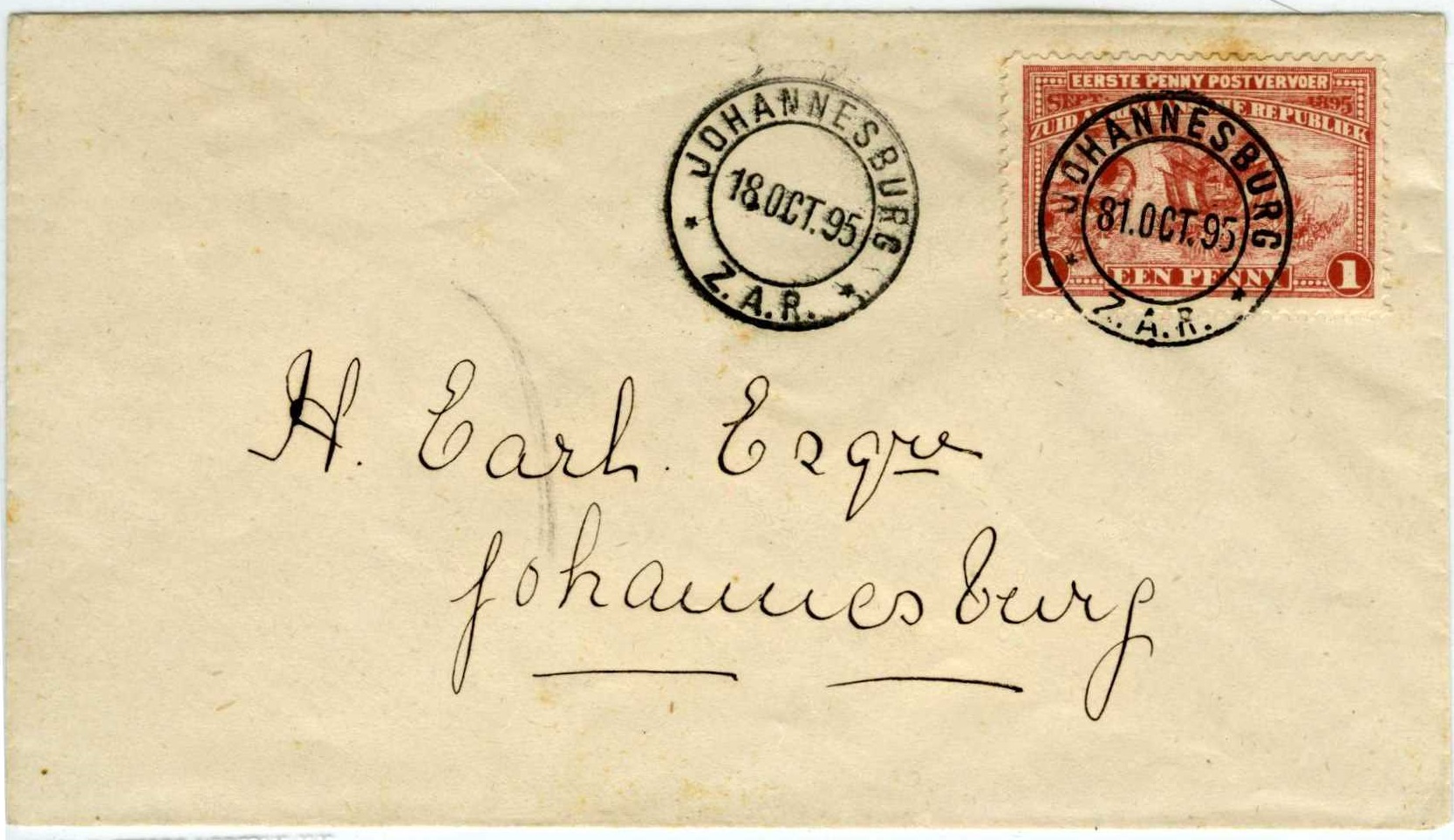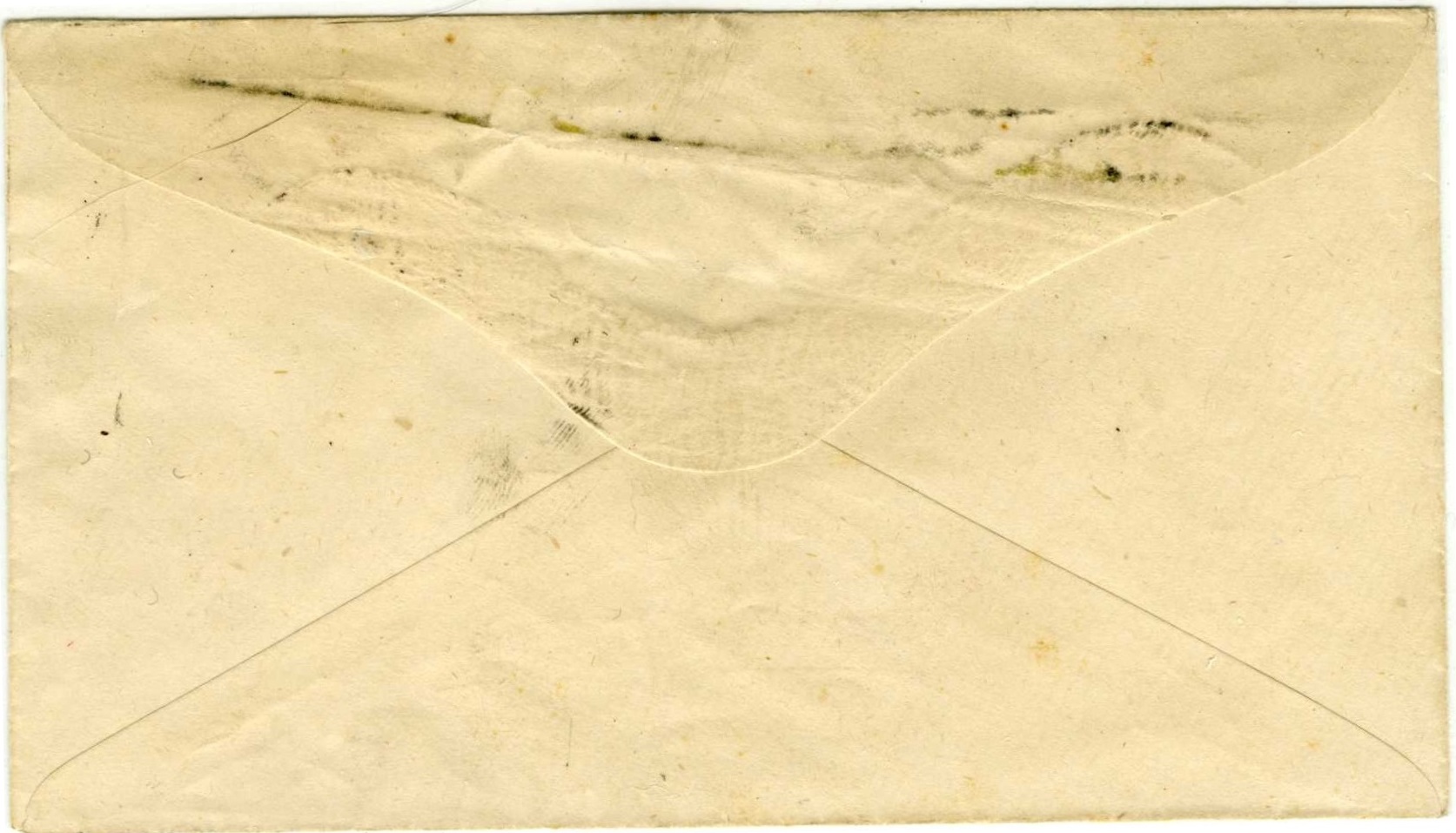Error or contrived?
Quote from Bas PAYNE on March 13, 2021, 6:54 pmI'd welcome comments on this cover, on which the Johannesburg postmark on the stamp is dated 81 OCT 95 (!) and the second postmark is dated 18 OCT 95.
It would be nice to think that the 81 in the postmark on the stamp was a simple error - postmark errors do happen: that the clerk perhaps noticed the wrong date, corrected the canceller, and postmarked the envelope for a second time. The stamp, the ZAR commemorative, was issued on 6 September 1895, and was in reasonably common use at the time. But there are hints of contrivance - the gum on the flap, for instance, is unused, and the issue of this stamp provoked quite a bit of philatelic speculation at the time.
The cover was addressed to H Earl, Johannesburg - has anyone come across his name on other covers?
What do you think?
I'd welcome comments on this cover, on which the Johannesburg postmark on the stamp is dated 81 OCT 95 (!) and the second postmark is dated 18 OCT 95.
It would be nice to think that the 81 in the postmark on the stamp was a simple error - postmark errors do happen: that the clerk perhaps noticed the wrong date, corrected the canceller, and postmarked the envelope for a second time. The stamp, the ZAR commemorative, was issued on 6 September 1895, and was in reasonably common use at the time. But there are hints of contrivance - the gum on the flap, for instance, is unused, and the issue of this stamp provoked quite a bit of philatelic speculation at the time.
The cover was addressed to H Earl, Johannesburg - has anyone come across his name on other covers?
What do you think?
Uploaded files:
Quote from Steve on March 14, 2021, 11:10 amI am not familiar with covers to H Earl Esq.
My first guess is that the postal clerk cancelled the stamp, then noticed his mistake and adjusted the datestamp before striking it again. I wonder why the cover was struck twice when once would have sufficed? The postal clerk's job was done once the stamp was cancelled. But, oops, look at that - the date is wrong. Perhaps the postal clerk was conscientious and on noticing the inverted date thought that he had better strike it again with the correct date?
Returning to the contrivance theory, the address or lack of it is intriguing. While Johannesburg was not nearly as big in 1895 as it was in 1899 - its growth at that time was exponential - it was probably already the largest town in South Africa, bigger even than Cape Town which was some 240 years older. A census conducted in January 1896 recorded that Johannesburg then had 102,078 inhabitants, of whom 61 292 lived within the three mile radius of Market Square and 40 786 outside. There were 50 907 Europeans or Whites in this group of which H Earl, Esq was one. My point is that the address on the cover is minimal and barely enough to guarantee delivery of the letter. It almost assumes that H Earl Esq was known to the Post Office. To me, this seems to add some weight to Bas' contrivance theory, suggesting this was created by the postal clerk for someone known to him? Perhaps. While I am no ZAR / Transvaal expert, it seems that dodgy philatelic goings on like this were not uncommon in the ZAR Post Office at that time.
I am not familiar with covers to H Earl Esq.
My first guess is that the postal clerk cancelled the stamp, then noticed his mistake and adjusted the datestamp before striking it again. I wonder why the cover was struck twice when once would have sufficed? The postal clerk's job was done once the stamp was cancelled. But, oops, look at that - the date is wrong. Perhaps the postal clerk was conscientious and on noticing the inverted date thought that he had better strike it again with the correct date?
Returning to the contrivance theory, the address or lack of it is intriguing. While Johannesburg was not nearly as big in 1895 as it was in 1899 - its growth at that time was exponential - it was probably already the largest town in South Africa, bigger even than Cape Town which was some 240 years older. A census conducted in January 1896 recorded that Johannesburg then had 102,078 inhabitants, of whom 61 292 lived within the three mile radius of Market Square and 40 786 outside. There were 50 907 Europeans or Whites in this group of which H Earl, Esq was one. My point is that the address on the cover is minimal and barely enough to guarantee delivery of the letter. It almost assumes that H Earl Esq was known to the Post Office. To me, this seems to add some weight to Bas' contrivance theory, suggesting this was created by the postal clerk for someone known to him? Perhaps. While I am no ZAR / Transvaal expert, it seems that dodgy philatelic goings on like this were not uncommon in the ZAR Post Office at that time.


